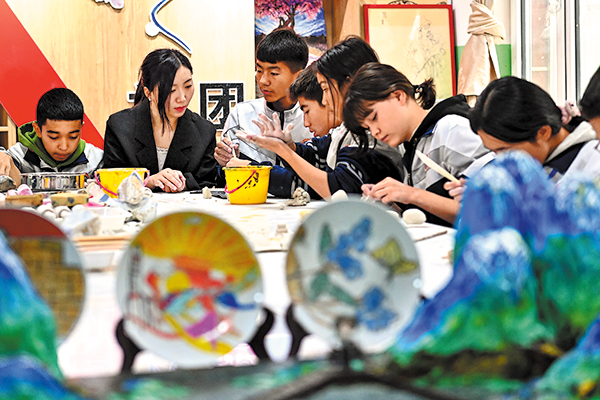Xinjiang gets education boost
Teachers, funding from Jiangxi help improve region's learning landscape


"I can get used to the distance as long as we are together, no matter how far," music teacher Yang Yuling from Jiangxi province sang with her students in the Xinjiang Uygur autonomous region.
Jiangxi and Xinjiang are separated by about 5,000 kilometers, but the hearts of people from the two regions are tightly connected at Xuesong Middle School in Aketao county, Kezilesu Kirgiz autonomous prefecture in Xinjiang.
"I listened to many Xinjiang folk songs as a child. I've been looking forward to this place for a long time," said Yang, who had been teaching at Pingxiang village of Jiangxi until a year ago. "Just as I imagined, children here are very good at singing and dancing. I'm happy they like my class."
Yang and her students have become close friends. They teach her songs, dances and language from their ethnic groups, which include Uygur, Kirgiz and Tajik.
When asked what they think of Yang, students gave glowing reviews: "She is pretty." "She can sing well." "She teaches beautiful songs."They share the same dream of one day "going to college".
Yang, 38, is one of 53 teachers from Jiangxi who volunteered to work at the school as part of a program to improve education in Xinjiang by transplanting quality teachers.
The school is the largest and top-ranked in the county, with 81 classes supporting a student population of about 4,000. It has received 112 million yuan ($15.5 million) in funding from Jiangxi, along with donated equipment to facilitate teaching. The school has four classroom buildings, two student dormitory buildings and one canteen.
In 2023, the school's college admission rate was 39.42 percent, ranking second in the prefecture, increasing by 9.69 percentage points from 2022.
The school introduced pottery, reading, poetry, paper-cutting, Chinese painting, calligraphy and music classes to enrich their students' imaginations.
Bumaryam Gul, an 18-year-old student of Yang's, said she wants to attend Xinjiang Normal University in Urumqi and become a music teacher like her.
Every day, Bumaryam rides a bike for 5 minutes to the school. She and her two brothers enjoy free tuition from primary to senior middle school.
"I get along well with my classmates and teachers. The environment and food are very good," she said.
Chen Zijing teaches pottery. She said she uses clay donated by a company in Jingdezhen city of Jiangxi. Her students make pottery sheep, cartoon characters and others. Many of the students' works have been recognized and won national awards. Aketao, like Jingdezhen, has a long history of pottery-making.
In Kuwanxibak Erkin's calligraphy class, students practice using electronic screens on their desks, which Jiangxi also donated.
He said that he used chalk and pens to teach three years ago, which was limiting. Thanks to the upgrade, the class has become much more popular among students.
"Many people forget how to write, as electronic tools replace most handwriting," he said, adding that from learning how to control the writing brush to writing strokes, words and sentences, students are able to improve their penmanship as well.
Nursultan Kuwanxibak, 15, has been learning calligraphy for a year.
"Calligraphy is a profound and extensive part of traditional Chinese culture. That's why I signed up for classes," he said. "It was a bit difficult at first, but it became easier in the later stages."
The school was built in 1972 as Aketao No 2 Middle School. In 2015, it moved to its current location and was renamed.
Yakupjan Dol, vice-president of the school, said the most advanced technology when he was in primary school was a slide projector, a far cry from modern infrastructure.
"There have been drastic changes from old days to modern times," he said.
According to him, as the government has paid greater attention to Xinjiang's education, more children have been able to attend school. Some have even been accepted to renowned universities.
He added that about 1,800 boarders receive free accommodation. Every summer and winter holiday, the county government organizes buses to send students back home to pasturing areas as far as 400 kilometers away.



































